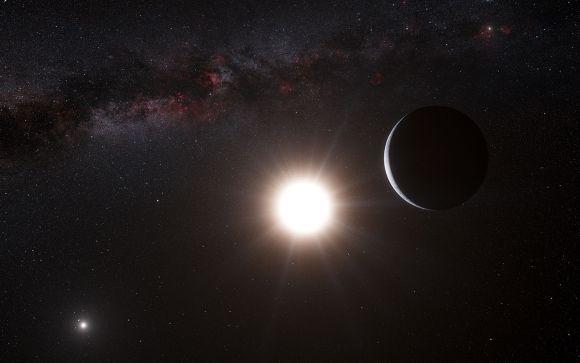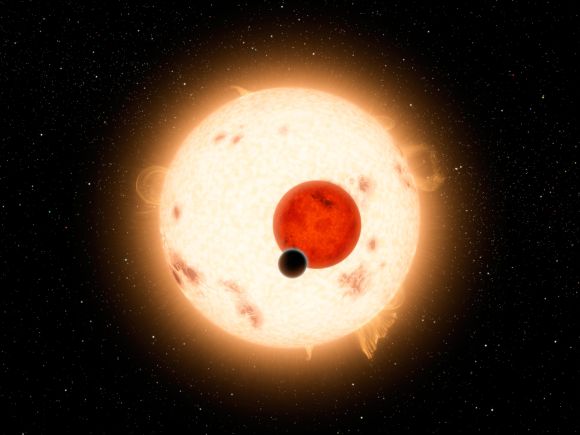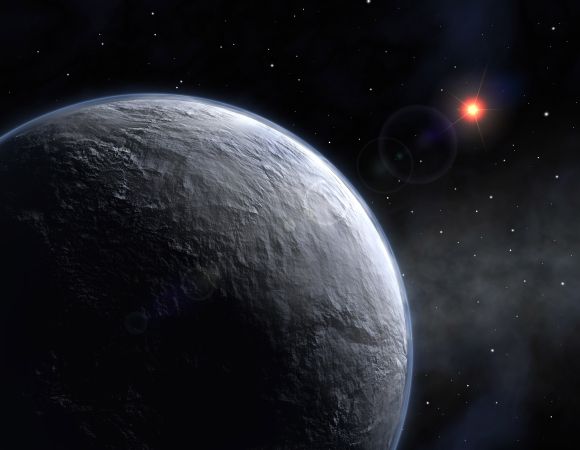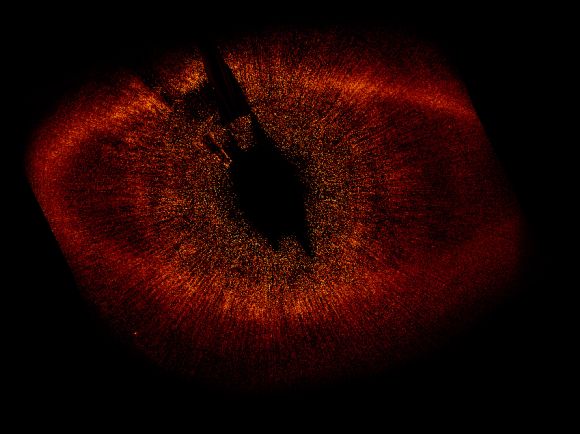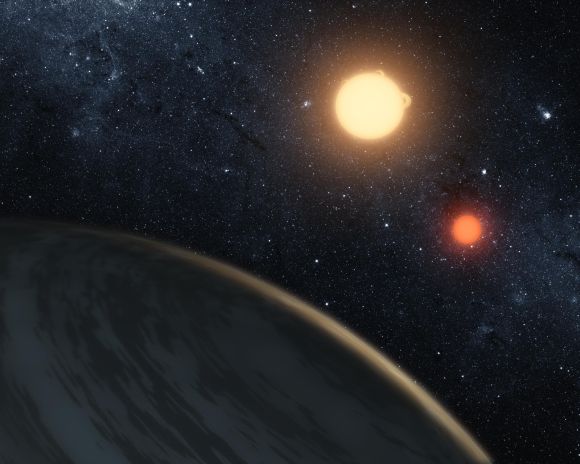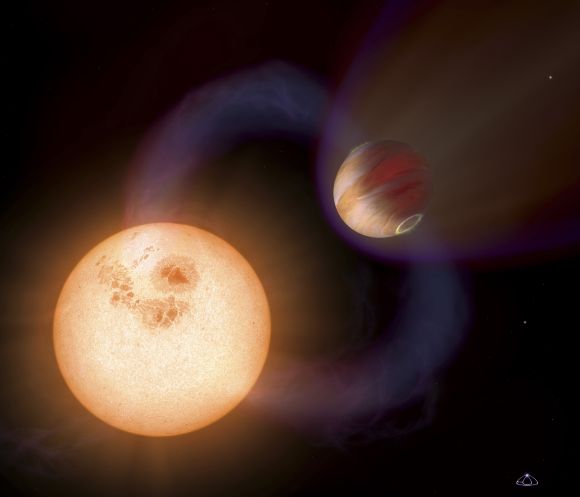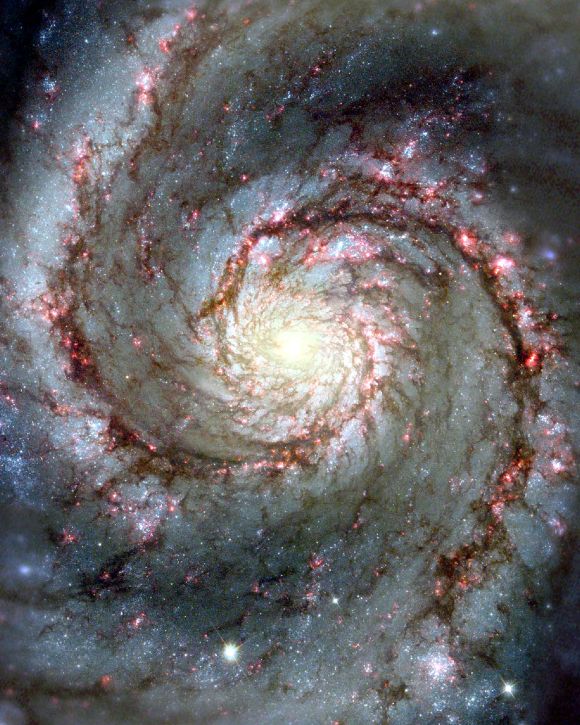 | « Back to article | Print this article |
IN PHOTOS: A closer look at some distant planets
Check these splendid impressions of planets by artists
This artist's impression shows the planet orbiting the star Alpha Centauri B, a member of the triple star system that is the closest to Earth in this image. Alpha Centauri B is the most brilliant object in the sky and the other dazzling object is Alpha Centauri A. Our own Sun is visible to the upper right.
It is also the lightest exoplanet ever discovered around a star like the Sun.
Click NEXT to see more PHOTOS...
IN PHOTOS: A closer look at some distant planets
This artist's impression shows a sunset seen from the super-Earth Gliese 667 Cc. The brightest star in the sky is the red dwarf Gliese 667 C, which is part of a triple star system. The other two more distant stars, Gliese 667 A and B appear in the sky also to the right. Astronomers have estimated that there are tens of billions of such rocky worlds orbiting faint red dwarf stars in the Milky Way alone.
Click NEXT to see more PHOTOS...
IN PHOTOS: A closer look at some distant planets
An artist's illustration of Kepler-22b, a planet known to comfortably circle in the habitable zone of a sun-like star, is seen in this undated handout picture released by NASA. Kepler-22b, the most Earth-like planet ever discovered is circling a star 600 light years away, a key finding in an ongoing quest to learn if life exists beyond Earth, scientists said.
Kepler-22b joins a list of more than 500 planets found to orbit stars beyond our solar system. It is the smallest and the best positioned to have liquid water on its surface - among the ingredients necessary for life on Earth.
Click NEXT to see more PHOTOS...
IN PHOTOS: A closer look at some distant planets
NASA handout image of an artist's concept illustrating an icy planet-forming disk around a young star called TW Hydrae, located about 175 light-years away in the Hydra, or Sea Serpent, constellation. Astronomers using the Herschel Space Observatory detected copious amounts of cool water vapor, illustrated in blue, emanating from the star's planet-forming disk of dust and gas.
The water vapor, which probably comes from icy grains in the disk, is located in the frigid outer regions of the star system, where comets will take shape.
Click NEXT to see more PHOTOS...
IN PHOTOS: A closer look at some distant planets
Astronomers searching the skies for distant planets have detected two Saturn-sized worlds orbiting distant suns, the smallest planets found thus far outside our solar system.
The discovery boosted the likelihood that even smaller planets - perhaps the size of Earth - exist elsewhere in the universe, Professor Steve Vogt of the University of California-Santa Cruz said. This artists concept shows a view of the discovered planet orbiting 79 Ceti.
Click NEXT to see more PHOTOS...
IN PHOTOS: A closer look at some distant planets
NASA handout image shows an artist's concept of the planet Kepler-16b with its two stars. The cold planet, with its gaseous surface, is not thought to be habitable. The largest of the two stars, a K dwarf, is about 69 percent the mass of our sun, and the smallest, a red dwarf, is about 20 percent the sun's mass. These star pairs are called eclipsing binaries.
Click NEXT to see more PHOTOS...
IN PHOTOS: A closer look at some distant planets
A newly discovered planet, designated by the unglamorous identifier of OGLE-2005-BLG-390Lb, orbits a red star five times less massive than the Sun and located at a distance of about 20,000 light years, in this undated artist's impression.
A new planet-hunting technique has detected the most Earth-like planet yet around a star other than our sun, raising hopes of finding a space rock that might support life, astronomers reported.
Click NEXT to see more PHOTOS...
IN PHOTOS: A closer look at some distant planets
Handout picture shows an artist's conception of a newly discovered planet being shown as a hot, rocky, geologically active world glowing in the deep red light of its nearby parent star, the M dwarf Gliese 876.
The heat and the reddish light are among the few things about the new planet that are certain, depending on the thickness and composition of its atmosphere - if any - it could range from being a barren, cratered ball of rock like Mercury or the Moon, to being a featureless, cloud-shrouded cue-ball like Venus.
Click NEXT to see more PHOTOS...
IN PHOTOS: A closer look at some distant planets
NASA's Hubble Space Telescope has taken the first visible-light snapshot of a planet circling another star in this image released by NASA. Estimated to be no more than three times Jupiter's mass, the planet, called Fomalhaut b, orbits the bright southern star Fomalhaut, located 25 light-years away in the constellation Piscis Australis, or the "Southern Fish."
Fomalhaut has been a candidate for planet hunting ever since an excess of dust was discovered around the star in the early 1980s by NASA's Infrared Astronomy Satellite, IRAS.
Click NEXT to see more PHOTOS...
IN PHOTOS: A closer look at some distant planets
NASA handout image shows an artist's concept of the circumbinary planet Kepler-16b - the first planet known to definitively orbit two stars. The cold planet, with its gaseous surface, is not thought to be habitable. The largest of the two stars, a K dwarf, is about 69 percent the mass of our sun, and the smallest, a red dwarf, is about 20 percent the sun's mass. These star pairs are called eclipsing binaries.
Click NEXT to see more PHOTOS...
IN PHOTOS: A closer look at some distant planets
An artist's impression shows a Jupiter-sized planet passing in front of its parent star. Such events are called transits. When the planet transits the star, the star's apparent brightness drops by a few percent for a short period. Through this technique, astronomers can use the Hubble Space Telescope to search for planets across the galaxy by measuring periodic changes in a star's luminosity.
The first class of exoplanets found by this technique are the so-called "hot Jupiters," which are so close to their stars they complete an orbit within days, or even hours.
Click NEXT to see more PHOTOS...
IN PHOTOS: A closer look at some distant planets
An artist's impression shows a unique type of exoplanet discovered with the Hubble Space Telescope. The planet is so close it to its star that it completes an orbit in 10.5 hours. The planet is only 750,000 miles from the star, or 1/130th the distance between Earth and the Sun.
The Jupiter-sized planet orbits an unnamed red dwarf star that lies in the direction of the Galactic Centre; the exact stellar distance is unknown.
Click NEXT to see more PHOTOS...
IN PHOTOS: A closer look at some distant planets
A new picture from the Hubble telescope are giving astronomers a detailed view of the Whirlpool galaxy's spiral arms and dust clouds, which are the birth sites of massive and luminous stars. This galaxy, also called M51 or NGC 5194, is having a close encounter with a nearby companion galaxy, NGC 5195, just off the upper edge of this image.
The companion's gravitational influence is triggering star formation in the Whirlpool, as seen by the numerous clusters of bright, young stars (highlighted in red).
Click NEXT to see more PHOTOS...
IN PHOTOS: A closer look at some distant planets
Image shows composite image of Elephant's Trunk Nebula, an elongated dark globule within the emission nebula IC 1396 in the constellation of Cepheus, one of the first images from the new Spitzer Space Telescope released by NASA.
The new Spitzer Space Telescope, that looks at the cosmos with infrared detectors, has lifted the dust veils from newborn stars and a bumptious comet, and revealed the detail in the spiral arms of a neighboring galazy. Unlike the [Hubble Space Telescope], which takes pictures of the universe from high in Earth orbit, Spitzer makes its observations as it trails behind Earth as our planet circles the sun.
TOP photo features of the week
Click on MORE to see another set of PHOTO features...
